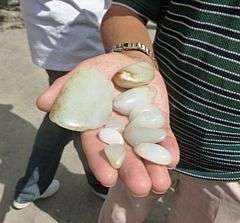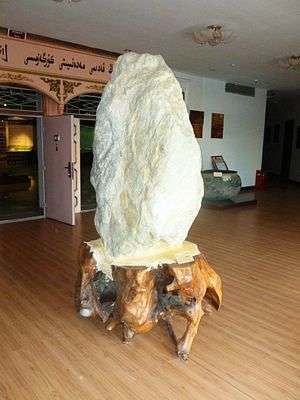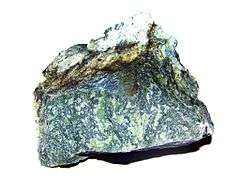Nephrite
| Nephrite | |
|---|---|
|
Nephrite from Jordanów Śląski (Poland) | |
| General | |
| Category | Mineral |
| Formula (repeating unit) | Ca2(Mg,Fe)5Si8O22(OH)2[1] |
| Crystal system | monoclinic[1] |
| Identification | |
| Color | Translucent to opaque and often mottled. Light to dark green, yellow to brown, white, gray, black.[1] |
| Crystal habit | massive[1] |
| Fracture | splintery to granular[1] |
| Mohs scale hardness | 6 – 6.5[1] |
| Luster | dull[1] |
| Specific gravity | 2.95 (+.15, -.05)[1] |
| Polish luster | vitreous to greasy[1] |
| Optical properties | Double refractive with anomalous aggregate reaction[1] |
| Refractive index | 1.606 – 1.632 (+.009, -.006)[1] |
| Birefringence | usually not detectable[1] |
| Pleochroism | none[1] |
| Ultraviolet fluorescence | inert[1] |
| Absorption spectra | Vague line may be present at 500 nm, but rarely any lines. Rarely, in stones of exceptional gem quality, vague lines in the red part of the spectrum may be seen.[1] |
Nephrite is a variety of the calcium and magnesium-rich amphibole mineral actinolite (aggregates of which also make up one form of asbestos). The chemical formula for nephrite is Ca2(Mg, Fe)5Si8O22(OH)2.[1] It is one of two different mineral species called jade. The other mineral species known as jade is jadeite, which is a variety of pyroxene. While nephrite jade possess mainly grays and greens (and occasionally yellows, browns or whites), jadeite jade, which is rarer, can also contain blacks, reds, pinks and violets. Nephrite jade is an ornamental stone, used in carvings, beads, or cabochon cut gemstones.
Nephrite can be found in a translucent white to very light yellow form which is known in China as mutton fat jade,[1] in an opaque white to very light brown or gray which is known as chicken bone jade,[1] as well as in a variety of green colors. Western Canada is the principal source of modern lapidary nephrite.[2] Nephrite jade was used mostly in pre-1800 China as well as in New Zealand, the Pacific Coast and Atlantic Coasts of North America, Neolithic Europe, and southeast Asia.
Name
The name nephrite is derived from lapis nephriticus, which in turn is derived from Greek λίθος νεφρίτίκος; νεφρός λίθος, which means 'kidney stone' and is the Latin and Greek version of the Spanish piedra de ijada (the origin of "jade" and "jadeite").[3] Accordingly, nephrite jade was once believed to be a cure for kidney stones.
Other names
Besides the terms already mentioned, nephrite has the following synonyms and varieties: aotea, axe-stone, B.C. jade, beilstein, kidney stone, lapis nephriticus, nephrit, nephrita, pounamu, New Zealand greenstone,[1] New Zealand jade,[1] spinach jade (dark grayish green),[1] and talcum nephriticus. Tomb jade or grave jade are names given to ancient burial nephrite pieces that have a brown or chalky white texture as a surface treatment.[1]
History
Neolithic and Chalcolithic Europe
A lot of nephrite tools and amulets are known since the Early Neolithic (VII mill. BC) to the Late Chalcolithic (V mill. BC) on the Balkans (mainly Bulgaria; also in Greece, Serbia, Croatia) from two or more unknown sources - Balkan "nephrite culture". Such tools are found in the Later Neolithic of Poland (from the most probable local source Jordanów), Sardinia (Italy) (unknown source) and Switzerland. Single or just a few finds of nephrite artifacts are reported also from some other European countries.
Prehistoric and historic China


During Neolithic times, the key known sources of nephrite jade in China for utilitarian and ceremonial jade items were the now depleted deposits in the Ningshao area in the Yangtze River Delta (Liangzhu culture 3400–2250 BC) and in an area of the Liaoning province in Inner Mongolia (Hongshan culture 4700–2200 BC). Jade was used to create many utilitarian and ceremonial objects, ranging from indoor decorative items to jade burial suits. Jade was considered the "imperial gem". From about the earliest Chinese dynasties until present, the jade deposits in most use were from the region of Khotan in the Western Chinese province of Xinjiang (jade deposits from other areas of China, such as Lantian, Shaanxi, were also in great demand). There, white and greenish nephrite jade is found in small quarries and as pebbles and boulders in the rivers flowing from the Kuen-Lun mountain range northward into the Takla-Makan desert area. River jade collection was concentrated in the Yarkand, and the White Jade (Yurungkash) and Black Jade (Karakash) Rivers in Khotan. From the Kingdom of Khotan, on the southern leg of the Silk Road, yearly tribute payments consisting of the most precious white jade were made to the Chinese imperial court and there transformed into objets d'art by skilled artisans, as jade was considered more valuable than gold or silver.
Māori

Nephrite jade in New Zealand is known as pounamu in the Māori language, and is highly valued, playing an important role in Māori culture. It is considered a taonga, or treasure, and therefore protected under the Treaty of Waitangi, and the exploitation of it is restricted and closely monitored. The South Island of New Zealand is Te Wai Pounamu in Māori — "The [land of] Greenstone Water" — because that is where it occurs.
Weapons and ornaments were made of it; in particular the mere (short club), and the hei-tiki (neck pendant). These were believed to have their own mana, were handed down as valuable heirlooms, and often given as gifts to seal important agreements. It was also used for a range of tools such as adzes, as Māori had no metal tools.
Commonly called "greenstone", jade jewellery in Māori designs is widely popular with tourists – although much of the jade itself is now imported from British Columbia and elsewhere.
References
| Wikimedia Commons has media related to Nephrite. |
- 1 2 3 4 5 6 7 8 9 10 11 12 13 14 15 16 17 18 19 20 21 22 Gem Reference Guide. Gemological Institute of America. 1988. ISBN 0-87311-019-6.
- ↑ Kirk Makepeace, George J. Simandl, Jade (Nephrite) in British Columbia, Canada; in G.J. Simandl, W.J. McMillan and N.D. Robinson, (editors), 37th Annual Forum on Industrial Minerals Proceedings, Industrial Minerals with emphasis on Western North America, Paper 2004-2-57, pages 287-288 (2004). Accessed October 30, 2016
- ↑ Easby, Elizabeth Kennedy (1968). Pre-Columbian Jade from Costa Rica. New York: André Emmerich Inc.
- Bale, Martin T. and Ko, Min-jung. Craft Production and Social Change in Mumun Pottery Period Korea. Asian Perspectives 45(2):159-187, 2006.
Further reading
- Histoire de la ville de Khotan: tirée des annales de la chine et traduite du chinois ; Suivie de Recherches sur la substance minérale appelée par les Chinois PIERRE DE IU, et sur le Jaspe des anciens. Abel Rémusat. Paris. L’imprimerie de doublet. 1820. Downloadable from:
- Laufer, Berthold, 1912, Jade: A Study in Chinese Archeology & Religion, Reprint: Dover Publications, New York. 1974.
- Rawson, Jessica, 1975, Chinese Jade Throughout the Ages, London: Albert Saifer, ISBN 0-87556-754-1
